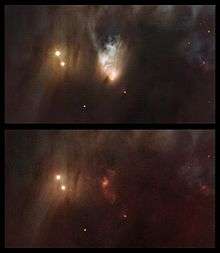McNeil's Nebula
McNeil's Nebula is a variable nebula discovered January 23, 2004 by Jay McNeil of Paducah, Kentucky. It is illuminated by the star V1647 Ori.[2]
| Reflection nebula | |
|---|---|
 McNeil's Nebula in 2006 (upper) and 2004 (lower) Credit: ESO/T. A. Rector/University of Alaska Anchorage, H. Schweiker/WIYN and NOAO/AURA/NSF and Igor Chekalin | |
| Observation data: J2000 epoch | |
| Subtype | variable nebula |
| Right ascension | 05h 46m 14s[1] |
| Declination | −00° 05′ 48″[1] |
| Distance | 1,600[1] ly |
| Apparent magnitude (V) | 15-16[1] |
| Apparent diameter | 1.3 x 0.95 arc min[1] |
| Constellation | Orion[1] |
| Designations | EQ J054614-00058[1] |
Overview
"Only recently discovered by amateur astronomer Julian W. McNeil II [Jay McNeil], this peculiar looking object is currently classified as a cometary-type reflection nebula. The newborn nebula was found while processing a wide field image of Orion's Messier 78 nebular region which was taken from McNeil's suburban backyard using a 3-inch refractor. Images taken of the area before September 2003 show absolutely no signs of the nebula nor its ruddy illuminating star, which can be seen near the object's southern apex. Preliminary research by Bo Reipurth (Univ. of Hawaii) reveals that the nebula was created when the deeply imbedded fetal star previously catalogued as IRAS 05436-0007 somehow erupted and went into outburst. The young star's sudden increase in brightness consequently resulted in the surrounding cocoon of gas and dust becoming illuminated much like a lighthouse would light up a foggy harbor. To actually capture such an eruption of a pre-main sequence star so early in its evolution is an extremely rare occurrence. Often regarded as FU Orionis or EX Lupii type events, these sudden outbursts represent a very elusive stage through which most stars are thought to pass as they make final adjustments with their surroundings before settling down and becoming stable objects much like our very own Sun." [3][4]
Quotes
"The idea that this thing, first seen on my 3-inch telescope, which one can easily hold using one hand, would be observed, within 48 hours, by a telescope of 342 tons was absolutely staggering." Jay McNeil[5]
Earlier Images
The nebula has been identified on images taken by Evered Kreimer in October 1966, but not in various other images taken between 1951 and 1991. The nebula appears therefore to be very variable in luminosity, and is a reflection nebula illuminated by a variable star of some kind, or with the star's light being variably obscured for some reason.[6] The nebula was not observed after 2004 until 2008, when it reappeared once more.
2018 Disappearance
In November 2018 the Sky & Telescope website reported that the nebula had disappeared. On November 5, an observer using the 500-mm Gemini telescope at the Iowa Robotic Observatory reported its disappearance. Another observer using a 30-inch Dobsonian telescope on November 3 also failed to detect the nebula.[7]
References
- Frommert, Hartmut; Kronberg, Christine. "McNeil's Nebula near M78". Retrieved 11 July 2019.
- "V1647 Ori". Simbad. Retrieved July 10, 2019.
- Best of AOP: McNeil's Nebula. National Optical Astronomy Observatory. Retrieved on 2008-06-29. archive
- "Best of AOP: McNeil's Nebula". www.caelumobservatory.com.
- David Whitehouse. "New star emerges from dust cocoon", BBC News, 12 February 2004. Retrieved on 2008-06-29.
- McNeil's Nebula near M78.
- Hannikainen, Diana. "The Case of the Vanishing Nebula". Sky & Telescope. Retrieved 16 November 2018.